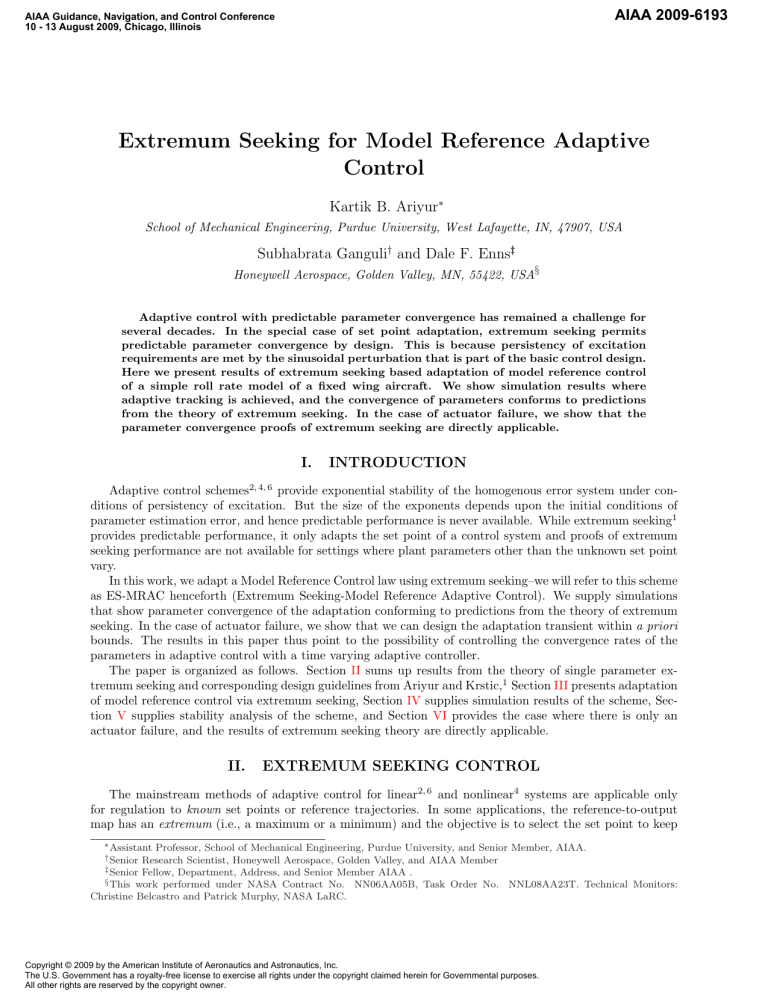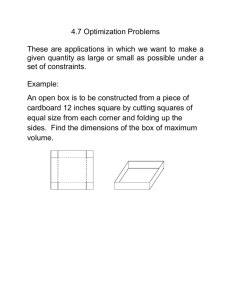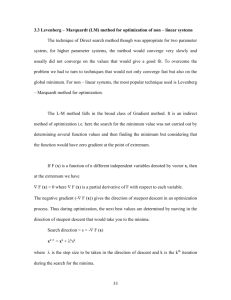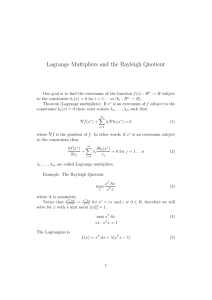
AIAA 2009-6193
AIAA Guidance, Navigation, and Control Conference
10 - 13 August 2009, Chicago, Illinois
Extremum Seeking for Model Reference Adaptive
Control
Kartik B. Ariyur∗
School of Mechanical Engineering, Purdue University, West Lafayette, IN, 47907, USA
Subhabrata Ganguli† and Dale F. Enns‡†
Honeywell Aerospace, Golden Valley, MN, 55422, USA§
Adaptive control with predictable parameter convergence has remained a challenge for
several decades. In the special case of set point adaptation, extremum seeking permits
predictable parameter convergence by design. This is because persistency of excitation
requirements are met by the sinusoidal perturbation that is part of the basic control design.
Here we present results of extremum seeking based adaptation of model reference control
of a simple roll rate model of a fixed wing aircraft. We show simulation results where
adaptive tracking is achieved, and the convergence of parameters conforms to predictions
from the theory of extremum seeking. In the case of actuator failure, we show that the
parameter convergence proofs of extremum seeking are directly applicable.
I.
INTRODUCTION
Adaptive control schemes2, 4, 6 provide exponential stability of the homogenous error system under conditions of persistency of excitation. But the size of the exponents depends upon the initial conditions of
parameter estimation error, and hence predictable performance is never available. While extremum seeking1
provides predictable performance, it only adapts the set point of a control system and proofs of extremum
seeking performance are not available for settings where plant parameters other than the unknown set point
vary.
In this work, we adapt a Model Reference Control law using extremum seeking–we will refer to this scheme
as ES-MRAC henceforth (Extremum Seeking-Model Reference Adaptive Control). We supply simulations
that show parameter convergence of the adaptation conforming to predictions from the theory of extremum
seeking. In the case of actuator failure, we show that we can design the adaptation transient within a priori
bounds. The results in this paper thus point to the possibility of controlling the convergence rates of the
parameters in adaptive control with a time varying adaptive controller.
The paper is organized as follows. Section II sums up results from the theory of single parameter extremum seeking and corresponding design guidelines from Ariyur and Krstic,1 Section III presents adaptation
of model reference control via extremum seeking, Section IV supplies simulation results of the scheme, Section V supplies stability analysis of the scheme, and Section VI provides the case where there is only an
actuator failure, and the results of extremum seeking theory are directly applicable.
II.
EXTREMUM SEEKING CONTROL
The mainstream methods of adaptive control for linear2, 6 and nonlinear4 systems are applicable only
for regulation to known set points or reference trajectories. In some applications, the reference-to-output
map has an extremum (i.e., a maximum or a minimum) and the objective is to select the set point to keep
∗ Assistant
Professor, School of Mechanical Engineering, Purdue University, and Senior Member, AIAA.
Research Scientist, Honeywell Aerospace, Golden Valley, and AIAA Member
‡ Senior Fellow, Department, Address, and Senior Member AIAA .
§ This work performed under NASA Contract No. NN06AA05B, Task Order No. NNL08AA23T. Technical Monitors:
Christine Belcastro and Patrick Murphy, NASA LaRC.
† Senior
Copyright © 2009 by the American Institute of Aeronautics and Astronautics, Inc.
The U.S. Government has a royalty-free license to exercise all rights under the copyright claimed herein for Governmental purposes.
All other rights are reserved by the copyright owner.
λf Γf (s)
λθ Γθ (s)
- Fi (s)
? ?
θf (θ)
- Fo (s)
ξ
θ̂
n
¾ −Ci (s)Γθ (s) ¾ ×n
¾
6
6
a sin(ωt)
Figure 1.
Plant
o (s) ¾
kC
Γf (s)
y
-
? n
m
¾
sin(ωt − φ)
Extension of the extremum seeking algorithm to non-step changes in θ∗ and f ∗
the output at the extremum value. The uncertainty in the reference-to-output map makes it necessary to
use some sort of adaptation to find the set point which extremizes (maximizes/minimizes) the output. The
emergence of extremum control dates as far back as the 1922 paper of Leblanc,5 whose scheme may very well
have been the first “adaptive” controller reported in the literature. The method of sinusoidal perturbation
used in this work has been the most popular of extremum-seeking schemes. In fact, it is the only method
that permits fast adaptation, going beyond numerically based methods that need the plant dynamics to
settle down before optimization. In this section, we provide the background and sum up the design results
for extremum seeking control.1 Figure 1 shows the nonlinear plant with linear dynamics along with the
extremum seeking loop. We let f (θ) be a function of the form:
f 00
2
(θ − θ∗ (t)) ,
2
f (θ) = f ∗ (t) +
(1)
where f 00 > 0 is constant but unknown. The purpose of extremum seeking is to make θ − θ∗ (t) as small
as possible, so that the output Fo (s)[f (θ)] is driven to its extremum Fo (s)[f ∗ (t)]. The optimal input and
output, θ∗ and f ∗ , are allowed to be time varying. Let us denote their Laplace transforms by
L{θ∗ (t)}
L{f ∗ (t)}
=
=
λθ Γθ (s)
λf Γf (s).
If θ∗ and f ∗ happen to be constant (step functions),
L{θ∗ (t)}
=
L{f ∗ (t)}
=
λθ
s
λf
.
s
While λθ and λf are unknown, the Laplace transform (qualitative) form of θ∗ and f ∗ is known, and is
included in the washout filter
Co (s)
s
=
Γf (s)
s+h
(where in the static case we had chosen Co (s) = 1/(s + h)) and in the estimation algorithm
Ci (s)Γθ (s) =
1
s
(where in the static case we had chosen Ci (s) = 1). Let us first shed more light on Γθ (s) and Γf (s) and then
return to discuss Ci (s) and Co (s).
By allowing θ∗ (t) and f ∗ (t) to be time varying, we are allowing for the possibility of having to optimize
a system whose commanded operation is non-constant. For example, if we have to ramp up the power of a
gas turbine engine, we know the shape of, say, f ∗ (t),
L{f ∗ (t)} =
λf
,
s2
but we don’t know λf (and λθ ). We include Γf (s) = 1/s2 into the extremum seeking scheme to compensate
for the fact that f ∗ is not constant. The inclusion of Γθ (s) and Γf (s) into the respective blocks in the
feedback branch of Figure 1 follows the well known internal model principle. In its simplest form, this
principle guides the use of an integrator in a PI controller to achieve a zero steady-state error. When
applied, in a very generalized manner, to the extremum seeking problem, it allows us to track time-varying
maxima or minima.
We return now to the compensators Co (s) and Ci (s). Their presence is motivated by the dynamics Fo (s)
and Fi (s), but also by the reference signals Γθ (s) and Γf (s). For example, if we are tracking an input ramp,
Γθ (s) =
1
,
s2
we get a double integrator in the feedback loop, which poses a threat to stability. Rather than choosing
Ci (s) = 1, we would choose Ci (s) = s + 1 (or something similar) to reduce the relative degree of the loop.
The compensators Ci (s) and Co (s) are crucial design tools for satisfying stability conditions and achieving
desired convergence rates.
We now make assumptions upon the system in Figure 1 that underlie the analysis leading to the design
theorem:
Assumption II.1 Fi (s) and Fo (s) are asymptotically stable and proper.
Assumption II.2 Γf (s) and Γθ (s) are strictly proper rational functions and poles of Γθ (s) that are not
asymptotically stable are not zeros of Fi (s).
This assumption forbids delta function variations in the map parameters and also the situation where
tracking of the extremum is not possible.
Assumption II.3
Co (s)
Γf (s)
and Ci (s)Γθ (s) are proper.
o (s)
This assumption ensures that the filters C
Γf (s) and Ci (s)Γθ (s) in Figure 1 can be implemented. Since
Ci (s) and Co (s) are at our disposal to design, we can always satisfy this assumption. The analysis does not
explicitly place conditions upon the dynamics of the parameters Γθ (s) and Γf (s), however, for any design to
yield a nontrivial region of attraction around the extremum, they cannot be faster than plant dynamics in
Fi (s) and Fo (s). The signal n in Figure 1 denotes the measurement noise.
A.
Single Parameter Stability Test
We first provide background for the result on output extremization below. The equations describing the
single parameter extremum seeking scheme in Fig. 1 are:
·
¸
f 00
∗
∗
2
y = Fo (s) f (t) +
(2)
(θ − θ (t))
2
θ = Fi (s) [a sin(ωt) − Ci (s)Γθ (s)[ξ]]
(3)
Co (s)
ξ = k sin(ωt − φ)
[y + n] .
(4)
Γf (s)
For the purpose of analysis, we define the tracking error θ̃ and output error ỹ:
θ̃
θ0
= θ∗ (t) − θ + θ0
= Fi (s) [a sin(ωt)]
(5)
(6)
ỹ
= y − Fo (s)[f ∗ (t)].
(7)
In terms of these definitions, we can restate the goal of extremum seeking as driving output error ỹ to a
small value by tracking θ∗ (t) with θ. With the present method, we cannot drive ỹ to zero because of the
sinusoidal perturbation θ0 .
We provide a result below that permits systematic design in a variety of situations. To this end, we
introduce the following notation:
Hi (s) =
Ho (s) =
Ho (s) =
Ci (s)Γθ (s)Fi (s)
Co (s)
k
Fo (s)
Γf (s)
Co (s)
4
4
sp
k
Fo (s) = Hosp (s)Hobp (s) = Hosp (s)(1 + Hobp
(s))
Γf (s)
(8)
(9)
(10)
where Hosp (s) denotes the strictly proper part of Ho (s) and Hobp (s) its biproper part, and k is chosen to
ensure
lim Hosp (s) = 1.
(11)
s→0
Now we make an additional assumption upon the plant:
Assumption II.4 Let the smallest in absolute value among the real parts of all of the poles of Hosp (s) be
denoted by a. Let the largest among the moduli of all of the poles of Fi (s) and Hobp (s) be denoted by b. The
ratio M = a/b is sufficiently large.
The purpose of this assumption is to use a singular perturbation reduction of the output dynamics and
provide the LTI SISO stability test of the theorem stated below. If the assumption were made upon the
output dynamics Fo (s) alone, the design would be restricted to plants with fast output dynamics Fo (s).
Hence, for generality in the design procedure, the assumption of fast poles is made upon the strictly proper
factor Hosp (s) of Ho (s). Its purpose is to deal with the strictly proper part of Fo (s). If we have slow poles
o (s)
in a strictly proper Fo (s), we can introduce a biproper C
Γf (s) with an equal number of fast poles to permit
analysis based design. For example, if
Fi (s) =
1
1
, and Fo (s) =
,
s+1
(s + 1)(2s + 3)
with constant f ∗ and θ∗ (giving Γθ (s) = Γf (s) = 1/s) we may set
Co (s) =
and k = 60 to give
Ho (s) =
(s + 4)
(s + 5)(s + 6)
Co (s)
60s(s + 4)
Fo (s) =
.
Γf (s)
(s + 1)(2s + 3)(s + 5)(s + 6)
We can factor the fast dynamics as
Hosp (s) =
30
(s + 5)(s + 6)
and the slow biproper dynamics as
sp
Hobp (s) = 1 + Hobp
(s) = 1 +
1.5(s − 1)
.
(s + 1)(s + 1.5)
This gives, in the terms of Assumption II.4, the smallest pole in absolute value in Hosp (s), a = 5, the largest
of the moduli of poles in Fi (s) and Hobp (s) as b = 1.5, giving their ratio M = a/b = 3.33. The singular
30
to its unity gain, and we deal with
perturbation reduction reduces the fast dynamics Hosp (s) = (s+5)(s+6)
stability of the reduced order model via the method of averaging to deduce stability conditions for the overall
system in the theorem below.
Theorem II.1 (Single Parameter Extremum Seeking) For the system in Figure 1, under Assumptions II.1–II.4, the output error ỹ achieves local exponential convergence to an O(a2 + δ 2 ) neighborhood of
the origin, where δ = 1/ω + 1/M provided n = 0 and:
1. Perturbation frequency ω is sufficiently large, and ±jω is not a zero of Fi (s).
2. Zeros of Γf (s) that are not asymptotically stable are also zeros of Co (s).
3. Poles of Γθ (s) that are not asymptotically stable are not zeros of Ci (s).
4. Co (s) and
1
1+L(s)
are asymptotically stable, where
L(s) =
af 00
Re{ejφ Fi (jω)}Hi (s).
4
(12)
.
From Eqn. (12), we notice that Ci (s) appears linearly in L(s) (through Hi (s) = Ci (s)Γθ (s)Fi (s)). This
property allows systematic design using linear control tools. The conditions of Theorem II.1 motivate the
steps of a design algorithm below.
B.
Single Parameter Compensator Design
In the design guidelines that follow, we set φ = 0 which can be used separately for fine-tuning.
Algorithm II.1 (Single Parameter Extremum Seeking)
1. Select the perturbation frequency ω sufficiently large and not equal to any frequency in noise, and with
±jω not equal to any imaginary axis zero of Fi (s).
2. Set perturbation amplitude a so as to obtain small steady state output error ỹ.
3. Design Co (s) asymptotically stable, with zeros of Γf (s) that are not asymptotically stable as its zeros,
o (s)
and such that C
Γf (s) is proper. In the case where dynamics in Fo (s) are slow and strictly proper, use
as many fast poles in Co (s) as the relative degree of Fo (s), and as many zeros as needed to have zero
relative degree of the slow part Hobp (s) to satisfy Assumption II.4.
4. Design Ci (s) by any linear SISO design technique such that it does not include poles of Γθ (s) that are
1
is asymptotically stable.
not asymptotically stable as its zeros, Ci (s)Γθ (s) is proper, and 1+L(s)
We examine these design steps in detail:
Step 1: Since the averaging assumption is only qualitative, we may be able to choose ω only slightly
larger than the plant time constants. Choice of ω equal to a frequency component persistent in the noise n
can lead to a large steady state tracking error θ̃. In fact, Theorem II.1 can be adapted to include a bounded
RT
noise signal satisfying limT →∞ T1 0 n sin ωtdt = 0. Finally, if ±jω is a zero of Fi (s), the sinusoidal forcing
will have no effect on the plant.
Step 2: The perturbation amplitude a should be designed such that a|Fi (jω)| is small; a itself may have
to be large so as to produce a measurable variation in the plant output.
o (s)
Step 3: In general, this design step will need designing a biproper C
Γf (s) when we have a slow and strictly
o (s)
proper Fo (s) in order to satisfy Assumption II.4. The use of fast poles in C
Γf (s) raises a possibility of noise
deteriorating the feedback; however, the demodulation coupled with the integrating action of the input
compensator prevents frequencies other than that of the forcing from entering into the feedback. While we
have used the gain k in analysis to satisfy Assumption II.4, this is not strictly necessary in design.
Step 4: We see from Algorithm II.1 that Ci (s) has to be designed such that Ci (s)Γθ (s) is proper; hence,
for example, if Γθ (s) = s12 , an improper Ci (s) = 1 + d1 s + d2 s2 is permissible. In the interest of robustness,
o (s)
it is desirable to design Ci (s) and Co (s) to ensure minimum relative degree of Ci (s)Γθ (s) and C
Γf (s) . This
will help to provide lower loop phase and thus better phase margins. Simplification of the design for Ci (s)
is achieved by setting φ = −∠(Fi (jω)), and obtaining
L(s) =
af 00 |Fi (jω)|
Hi (s).
4
The attraction of extremum seeking is its ability to deal with uncertain plants. In our design, we can
accommodate uncertainties in f 00 , Fo (s), and Fi (s), which appear as uncertainties in L(s). Methods for
treatment of these uncertainties are dealt with in texts such as.7 Here we only show how it is possible to
ensure robustness to variations in f 00 . Let fc00 denote an a priori estimate of f 00 . Then we can represent
1
1+L(s)
as
1
1+L(s)
=
1 ¶
µ
,
00
1+ 1+ ∆f
P (s)
d
00
where ∆f 00 = f 00 − fc00 , and P (s) =
00
fc
f 00 L(s),
which is at our disposal
f
P
because f 00 in P (s) gets cancelled by f 00 in L(s). We design Ci (s) to minimize k 1+P
kH∞ which maximizes
P
00
00
c
the allowable ∆f < f /k 1+P kH∞ under which the system is still asymptotically stable.
III.
ES-MRAC: ADAPTING MODEL REFERENCE CONTROL VIA
EXTREMUM SEEKING
Figure 2 shows the ES-MRAC scheme for the roll rate model with extremum seeking for both parameters.
It uses the reference model,
ẋm = am xm + bm r
(13)
for the roll rate model,
ẋ = ax + bu,
(14)
with control input
u = kx x + kr r
where r is the reference setting, and x is the roll rate. The model reference error is defined as
e , x − xm
(15)
If we define the ideal coefficients kx∗ and kr∗ as the ones that get the system to match the reference model,
we have
kx∗ = (am − a)/b, kr∗ = bm /b
(16)
We now consider the application of extremum seeking to optimize the value of a suitable function of the
error e, which we will denote by y = f (e) = e2 /2. In this problem, the optimum f ∗ = 0, and y is subject
to step changes if we assume that the reference input r is a step. The extremum seeking scheme has the
standard configuration of a washout filter, modulation and demodulation and an integrator for parameter
tracking for each parameter in the control law, with a compensator to provide damping (d1 and d2 ).
IV.
ESMRAC DESIGN AND SIMULATION RESULTS
Figures 3, 4, and 5 show the performance of the system of Figure 2 when the design parameters are chosen
as follows according to the design algorithm II.1: perturbation amplitudes a1 = a2 = 0.3; perturbation
frequencies ω1 = 8rad/sec, ω2 = 11rad/sec; gains kx = 2000, kr = 4000; damping d1 = d2 = 0.1; and
washout filter poles h1 = 4rad/sec, h2 = 5.6rad/sec. The stability theorem for single parameter extremum
seeking II.1 yields an approximate estimate of the exponent of the closed loop system at around -0.7283
(taking into account the true plant and an actuator pole assumed at -20 rad/sec and substituting into
Eqn. (12)) in steady state (assume we start with the true plant close to the reference plant). This in turn
yields a settling time of around 4 seconds, a fact borne out in the simulations.
V.
ANALYSIS OF THE ES-MRAC SCHEME
The object of the ES-MRAC scheme in Figure 2 is to ensure zero model reference error and adapt the
control gains kx and kr in the control law
u = kx x + kr r
to their ideal values
kx∗ ≡
am − a ∗
bm
, kr ≡
b
b
so that the output of the plant
ẋ = ax + bu
Figure 2. ES-MRAC Scheme
Step response
roll rate, degrees/sec
15
10
5
0
0
5
10
15
time, seconds
Figure 3. Adaptive step response
matches the output of the reference model
ẋm = am xm + bm r
for the reference input r.
Extremum seeking does not seek to obtain exact convergence of the parameters to their ideal values, but
rather to obtain convergence of their average values to the ideal values. As can be seen from the figure, the
scheme involves continuously perturbing the parameter values in order to change them to minimize the cost
function y=f (e,). We considered several cost functions in our simulation studies:
y = e2 , y = ė2 , y = |e|
All of the these produced consistent convergence of adaptation. Given this success, there arises the question
whether rigorous stability proofs exist for these schemes under a variety of conditions, which in turn would
permit systematic design of the adaptation parameters in the extremum seeking—ω1 , a1 , φ1 , h1 , and g1
for the kx adaptation, and ω2 , a2 , φ2 , h2 , and g2 for the kr adaptation. We perform analysis of the scheme
along the lines of analysis performed for extremum seeking schemes. For analysis of the ES-MRAC scheme
Control input
15
aileron deflection, degrees
10
5
0
−5
−10
−15
−20
−25
0
5
10
15
time, seconds
Figure 4. Control input during adaptation
in Figure 2, we write down its governing equations as follows:
g1
s
bm
ξ1 a1 sin (ω1 t) sin (ω1 t − φ1 )
s
s + h1 s − am
g2
s
− ξ2 a2 sin (ω2 t) sin (ω2 t − φ2 )
s
s + h2
ax + bu
f (e, ė)
g1
s
bm
− ξ1 a1 sin (ω1 t) sin (ω1 t − φ1 )
s
s + h1 s − am
g2
s
− ξ2 a2 sin (ω2 t) sin (ω2 t − φ2 )
s
s + h2
k̂x
= −
(17)
k̂r
=
(18)
ẋ
y
=
=
k̂x
=
k̂r
=
(19)
(20)
(21)
(22)
To examine convergence of the extremum seeking loops as in Section II, we define error variables k̃x and k̃r ,
perturbation signals kx0 and kr0 , and tracking error ỹ:
k̃x
k̃r
≡
≡
kx∗ − kx + kx0
kr∗ − kr + kr0
kx0
ỹ
≡
≡
a1 sin ω1 t, kr0 ≡ a2 sin ω2 t
y − f ∗ = y (assuming f ∗ = 0) ,
The equation for the model reference error e can then be written as:
(23)
Parameter adaptation
kx, seconds
0
−1
−2
−3
−4
0
5
0
5
10
15
10
15
kr, seconds
6
4
2
0
−2
time, seconds
Figure 5. Parameter convergence
³
³
´´
³
´
³
´
ė = am + b kx0 − k̃x e + b kx0 − k̃x xm + b kr0 − k̃r r,
The reference trajectory xm is governed by the reference model:
ẋm = am xm + bm u
And the equations for the gains can be written as:
kx
ξ1
=
=
kx0 − gs1 [sin (ω1 t − φ1 ) ξ1 ] , kr = kr0 −
s
s
s+h1 [y] , ξ2 = s+h2 [y]
g2
s
[sin (ω2 t − φ2 ) ξ2 ]
We write the outputs of the washout filters in the following form for analysis:
³
´
h1
h1
ξ1 = 1 − s+h
[y] = y − ξ1‘ , ξ1‘ ≡ s+h
[y]
1´
1
³
h2
h2
[y] = y − ξ2‘ , ξ2‘ ≡ s+h
ξ2 = 1 − s+h
[y]
2
2
We can now write the equations for the parameter tracking error variables as follows:
˙
k̃x
˙
k̃r
=
=
£
¡
¢¤
g1 sin (ω1 t − φ1 ) y − ξ1‘
£
¡
¢¤
g2 sin (ω2 t − φ2 ) y − ξ2‘
(24)
(25)
A.
AVERAGING ANALYSIS
As with the analysis of extremum seeking, we apply the method of averaging (see for example, Chapter 9 in
the book Nonlinear Systems, by H. K. Khalil3 ) to study the stability of the ES-MRAC scheme. The terms
ξ1‘ and ξ2‘ fall out as the terms containing them average out to zero in the parameter tracking equations. So
we only need consider four equations, and given that the reference model is independent of the other three,
we have only three differential equations.
The period of averaging is taken as the lowest common multiple of the periods of the two perturbation
2π
2π
frequencies ω1 and ω2 . If T be the time period of averaging, we have T = p ω
= qω
, where p and qare
1
2
natural numbers. Before performing the averaging, we perform a scaling of the time unit to obtain the small
parameter used for averaging. We set τ = ω1 twhere we assume that ω1 < ω2 and obtain a transformed set
of governing equations:
³
³
´´
³
´
³
´
q
de
1
=
a
+
b
a
sin
τ
−
k̃
e
+
b
a
sin
τ
−
k̃
x
+
b
a
sin
τ
−
k̃
r
m
1
x
1
x
m
2
r
dτ
ω1
p
¡
¢
dk̃x
1
‘
= ω1 g1 sin (τ
dτ
³ − φ1 ) ´y ¡− ξ1 ¢
dk̃r
1
= ω1 g2 sin pq τ − φ2 y − ξ2‘
dτ
The above set of equations is time varying and nonlinear; we arrive at an averaged system of equations by
integrating the right hand side of the equations over the period T, taking the state variables constant. In
all of the cases, we need to use higher order averaging theorems to establish stability.
For the cost function y = ė2 , we get the following averaged equations (after a long sequence of calculations):
h³
´
i
deav
= ω11 am − bk̃x,av eav − bk̃x,av xm,av − bk̃r,av r
dτ
h³
´
i
dk̃x,av
1
=
g
cos
φ
ba
(e
+
x
)
a
−
b
k̃
e
−
b
k̃
x
−
b
k̃
r
3
1
1
1
av
m,av
m
x,av
av
x,av
m,av
r,av
dτ
ω1
h³
´
i
dk̃r,av
= ω13 g2 cos φ2 ba2 r am − bk̃x,av eav − bk̃x,av xm,av − bk̃r,av r
dτ
dxm,av
dτ
1
=
1
ω1
[am xm,av + bm r]
The averaged error equation is the same for all cost functions based on e, and for all of the cost functions
considered, we found equilibria at
eav = 0, k̃r,av =
bm
k̃x,av
am
for the error system using the equilibrium xm,av = − abm
rfor the reference model. This might account for
m
some of our simulation results, where the parameter estimates converge to values other than the expected
ideal values, while the error still converges to zero. Nevertheless, convergence in simulation to the ideal
parameter values for a variety of initial conditions suggests a stability proof exists for some set of initial
conditions in parameter estimation errors.
VI.
ACTUATOR FAILURE
In the case where am = a in Figure 2, and there is only a change in b, e.g., a degradation in the actuator,
the adaptation problem is almost identical to the extremum seeking problem of set point optimization. The
only difference is the presence of an unknown gain in the loop (the value of b). The method at the end of
Section II can be used to design a robust extremum seeking loop and we can know the exponent of parameter
convergence to within an interval of uncertainty determined by the interval of uncertainty of b.
VII.
CONCLUDING REMARKS
This work raises two key questions. The first is whether it is possible to achieve completely controlled
parameter convergence in adaptive control with a time varying adaptive controller. The second is what is
the structure of the measurements and control inputs that will permit this predictable convergence. We will
complete this analysis to obtain conditions for global stability of parameter tracking. Indeed, we have these
exponents from linearization of the averaged equations. For the case where only the change in b or actuator
failure needs adaptation to, the proofs of the standard extremum seeking techniques1 already hold.
VIII.
ACKNOWLEDGMENTS
The authors thank Dr. Michael R. Elgersma for several helpful discussions.
References
1 K.
B. Ariyur and M. Krstić, Real-Time Optimization by Extremum Seeking Control, John Wiley & Sons, Hoboken, NJ,
2003.
2 P.
A. Ioannou and J. Sun, Robust Adaptive Control, Prentice-Hall, Englewood Cliffs, NJ, 1995.
K. Khalil, Nonlinear Systems, 2nd edition, Prentice-Hall, Upper Saddle River, NJ, 1996.
4 M. Krstić, I. Kanellakopoulos, and P. V. Kokotović, Nonlinear and Adaptive Control Design, John Wiley & Sons, NY,
1995.
5 M. Leblanc, “Sur l’electrification des chemins de fer au moyen de courants alternatifs de frequence elevee,” Revue Generale
de l’Electricite, 1922.
6 K. S. Narendra and A. M. Annaswamy, Stable Adaptive Systems, Dover Publications, NY, 2005.
7 K. Zhou, J. Doyle, and K. Glover, Robust and Optimal Control, Prentice Hall, 1995.
3 H.








